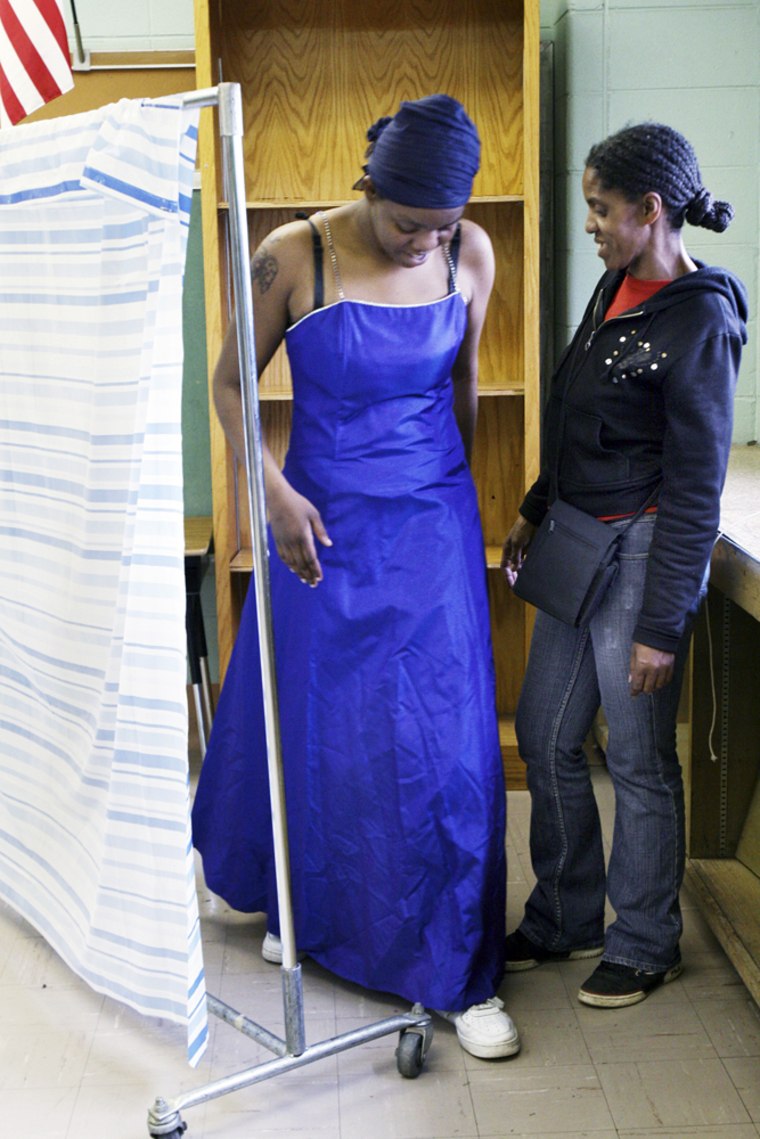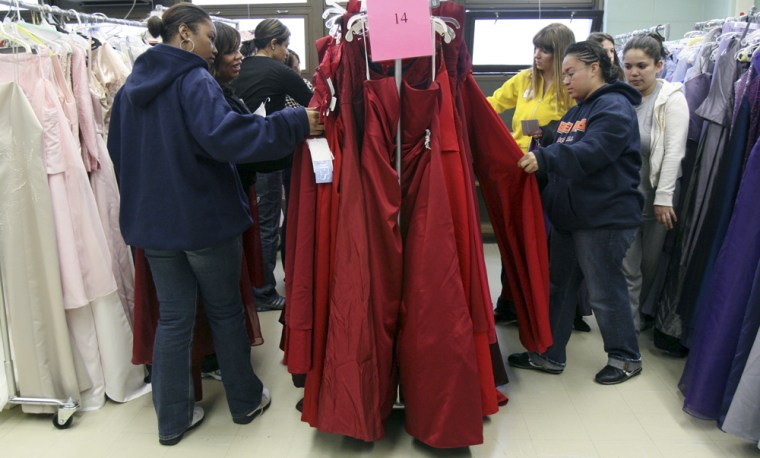xyzMaya Thomas and her mother arrived at 6 a.m. on a recent Saturday to wait in a school gym with hundreds of other young women. They were there on a mission — to find a free dress so Maya, whose mother is unemployed, could attend her senior prom.
“It’s hard, especially with my mother being a single parent and her doing this all by herself,” said the soft-spoken 18-year-old, who rested her head on her mother’s shoulder as they waited. “So this really means a lot to me.”
These days, it’s not unusual for teens to spend several hundred or even a thousand dollars on prom. But as more families struggle financially — and others simply find it distasteful or unnecessary to spend so much — the low-cost prom is becoming more common, and in some cases, socially acceptable.
“The prom certainly carries tremendous cultural weight and is, in many ways, the epitome of high school,” says Amy Best, an associate professor of sociology at George Mason University in Virginia and author of “Prom Night: Youth, Schools and Popular Culture.”
“So yes, the pressure is very significant to spend. But there are a lot of kids who are opting out and who are unwilling to spend.”
Or they simply can’t afford it.
Organizers at the Chicago-based Glass Slipper Project, where Maya got her dress, say they are hearing from more families who’ve been hit hard in this latest economic downturn.
“The parents will tell you, ‘If this hadn’t been available, I wouldn’t have been able to do it because I don’t have a job, or I lost my job, or my house foreclosed,’” says Carolyn Johnson, a Glass Slipper board member and an administrator with Chicago Public Schools. “You hear all kinds of stories.”
It’s been much the same this year at San Francisco’s Princess Project, one of several groups across the country that help young women find donated dresses. Since launching in 2002, the group has added locations in Silicon Valley and Oakland, Calif. — and is now considering other parts of California because of the demand.
“Girls are traveling two hours, just to come and find a dress,” says Yvette Nichols, the Princess Project board president.
Some of the young women just want a glamorous look to fit in. But even some students who can afford to buy their own dresses have made a conscious decision to get inexpensive ones and spend less on prom.
“It is kind of a bragging thing — you know, to spend $300 on a dress,” says Emily Maas, a senior at University High School in Tucson, Ariz. “But for me, it’s almost embarrassing to spend that much.”
She and her parents spent $160 on a dress for her prom, which was last month — and even that amount, she says, was a real splurge for her.
“I’ve always been the kind of person that if I get something on sale, it feels more rewarding,” says Emily, who’s 17.
So, to balance things out, she got the pumps she wore to prom at Payless Shoes and wore $5 earrings. Her boyfriend used a tux he’d bought for a family wedding. And they decided to go all out on a $30-a-person dinner instead of spending $70 each on a “party bus” with friends.
Other students, she says, cut back even more, by wearing dresses they already had and going to McDonald’s for dinner.
And at some high schools, it’s also become more common for prom-goers to go the second-hand route.
Officials at the Savers/Value Village chain of thrift stores, for instance, say they’ve seen a noticeable increase in prom-related business. Some of it is due to the economy, while other teens are interested in the idea of recycling a dress or going for a unique look.
Petra Tank, a 16-year-old student at Concord Academy in Petoskey, Mich., spent $7.50 on a floor-length turquoise halter dress she found at a resale shop in her small hometown in the state’s northern lower peninsula. Her entire outfit cost about $42 and included a “two buck” broach she sewed on the dress as an accent.
“I had compliments all night long,” she says, noting that her date’s attire included a skinny black tie and Converse tennis shoes.

Now, Tank adds, she’s not in debt like her best friend who spent $170 on a coral beaded gown. “She has a payment plan with her mother to pay for the dress until August. It’s just ridiculous!” she says, laughing.
Eighteen-year-old Kubby Martin went to a previous prom in a borrowed maroon tux, but is going the more traditional route for his senior prom this year and renting a tux.
“It’s not so much that I want to spend that much — but it’s what I need to do to look right,” Martin says. He’s a senior at Bellevue High School in Washington state, where this year’s prom theme is “Old Hollywood.” Between his prom and the one he attended at his girlfriend’s high school, he figures he (and his mom) could end up spending close to $1,000 on everything.
It’s not easy, since he’s spending so much more on gas for his car. “But I just want it to be special,” he says.
Back in Chicago, Maya Thomas was certain her prom would be special, thanks to the dark blue, floor-length dress with rhinestones and matching accessories she got for free. She’d never worn makeup before, she said — never had a dress like this, never attended a prom until now.
Hearing Maya’s story made Glass Slipper co-founder Dorian Carter teary.
“I tend to cry all the time,” Carter says. “Anybody that comes in and leaves with a dress, I’m happy.”
